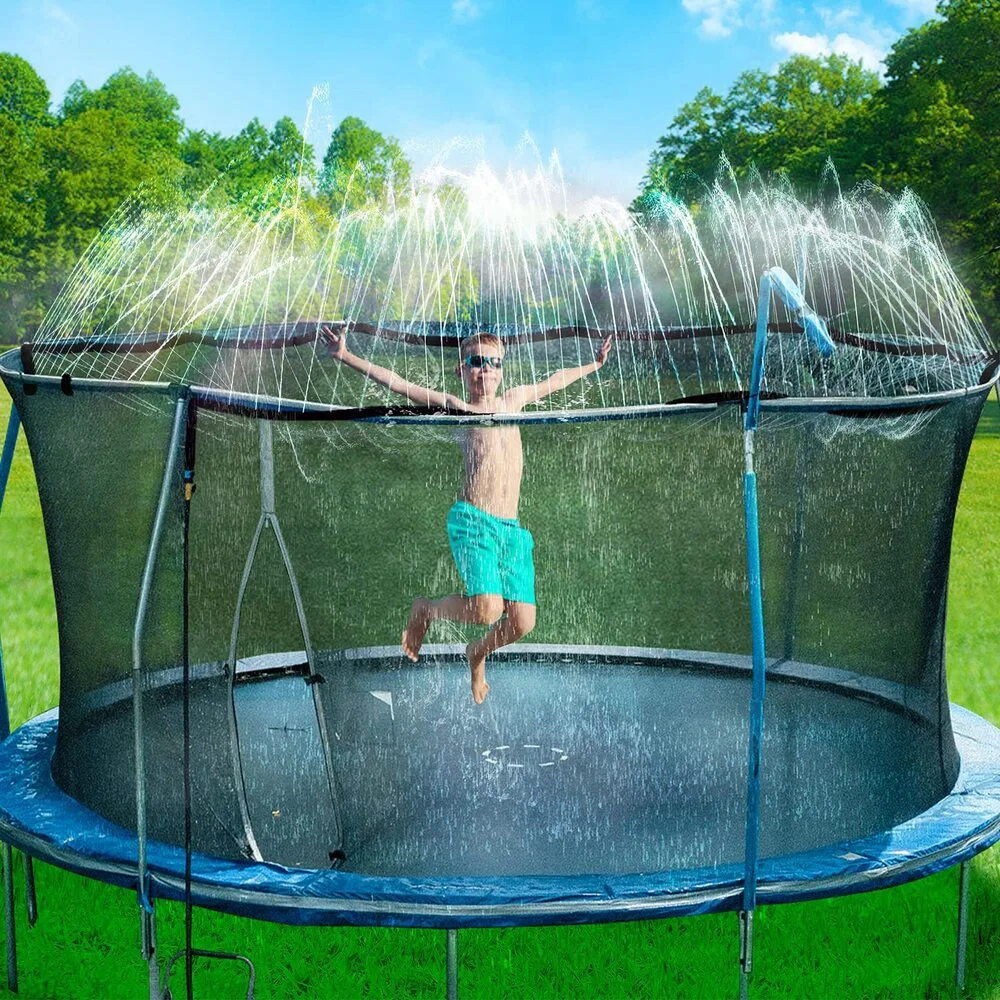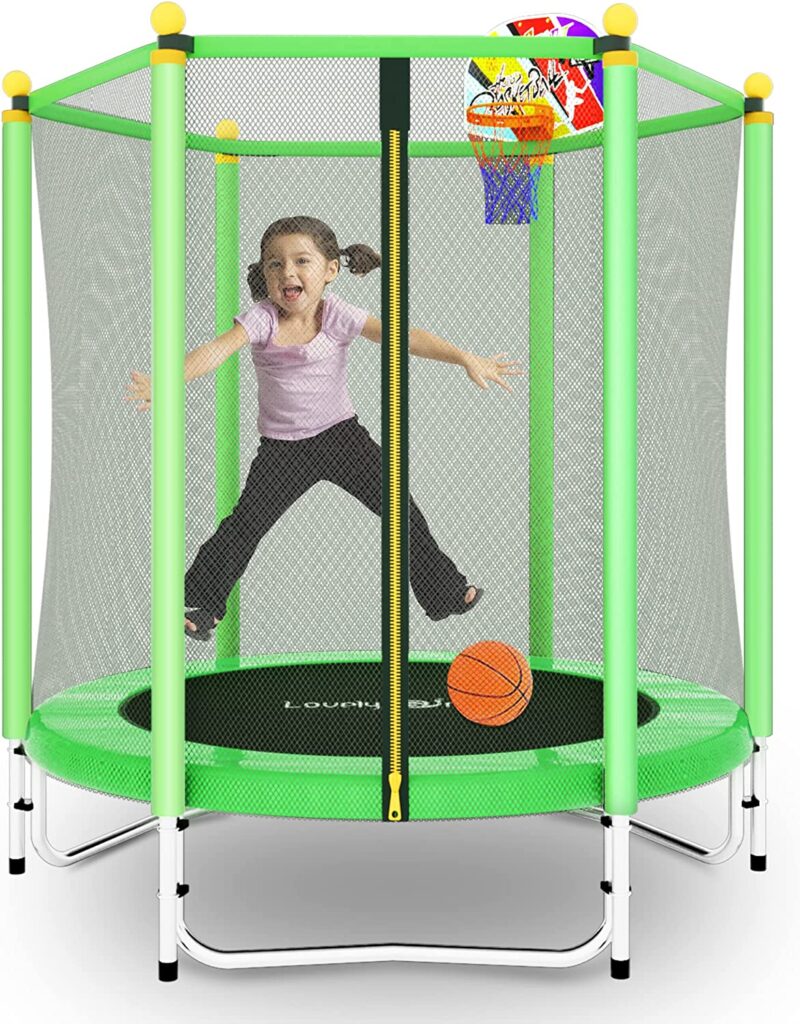
Best children’s trampoline
Trampolines are a great option for a fun and useful pastime for both children and adults. And if at first it may seem that this is a completely universal and the same projectile in all versions, differing only in size, then this is not so. The weight and total number of participants, the type, type of cover, the presence of a protective net, safety and the number of springs – all this and much more affects the choice. We figure out how not to get confused in such a variety.
And if you are interested in pools for children, we have a detailed overview of how to choose a pool for a child.
Features of trampolines: what and for what you choose
On this sports equipment, you can perform various tricks (jumps, somersaults), use it as an arena for games or training. In addition to active and fun pastime, trampolining strengthens the muscles of the legs and arms, improves coordination of movements, and helps to master the gymnastic elements.
Being engaged on a trampoline (game or training), you can:
- start the process of producing endorphins, as a result, raising your mood and others;
- improve the functioning of the heart, the circulatory system and the overall well-being of the whole organism;
- lose weight;
- remove toxins and harmful substances from the body;
- train different muscle groups – from legs, arms and buttocks to the press and back muscles;
- improve endurance, coordination;
- develop the vestibular apparatus.
What else is a trampoline useful for
 In addition to the entertainment function, the simulator is actively used for training – it is not for nothing that trampoline arenas have become especially popular recently, where fitness trainers conduct classes. But you can do it at home too. How tempting the numbers are: 8 minutes of trampolining equals 3 km of running, and a third of an hour of jumping replaces 60 minutes of step training. At the same time, fatigue is pleasant, a surge of strength and energy is palpable.
In addition to the entertainment function, the simulator is actively used for training – it is not for nothing that trampoline arenas have become especially popular recently, where fitness trainers conduct classes. But you can do it at home too. How tempting the numbers are: 8 minutes of trampolining equals 3 km of running, and a third of an hour of jumping replaces 60 minutes of step training. At the same time, fatigue is pleasant, a surge of strength and energy is palpable.
The construction of a trampoline consists of a fabric or mesh that is firmly and tautly stretched over a frame or air cushion. This form allows the simulator to withstand considerable dynamic loads. Jumps and other movements are possible thanks to springs – from one end they are fixed to the frame (the attachment points are support arcs or legs), from the other end they are attached to the floor. Some models of trampolines are equipped with a protective net on the racks. The springs are covered with mats of several layers of foam rubber and upholstery fabric.
Thus, a standard trampoline consists of:
- round frame and legs-stands;
- spring block located along the perimeter of the simulator;
- protective mats and coatings;
- racks and grids;
- stairs;
- upholstery material.
Types of trampolines: from room to sport and outdoor
Design, size, purpose – the main criteria for dividing trampolines into groups.
A large group of frame products includes different types of trampolines, united by a single design – fabric or mesh is stretched over a reliable frame. There are indoor and outdoor, game and sports, mini-trampolines.
You can choose a trampoline and read reviews here.
Indoor frame trampolines
Theoretically, if the area of the room allows, then any design can be installed at home or in an apartment. However, here the obstacle will be the height of the ceilings. Classic trampolines 27-35 inch in height will not work – there is a big risk of hitting your head on the ceiling. To avoid such a problem, manufacturers began to produce variants of trampolines with legs of 8-12 inch. While maintaining the standard spring block, the amplitude in terms of sagging depth remains the same as that of the classic models, but the child will be completely safe, since he simply will not reach ceiling.
Such trampolines with or without a net are chosen both for home fitness, installation in children’s rooms of apartments, houses, cottages, as well as in kindergartens.
Pros of indoor trampolines
- Optimum design height for low ceilings.
- Spring properties are not inferior to models for the street.
- Wide mats over springs, strong thick legs.
- You don’t need a ladder to climb up due to the low height of the legs.
- Compact and hassle-free movement.
- Low cost.
Cons of indoor trampolines
- Limited maximum allowable weight.
- Only some models of this type are equipped with a protective grid.
Outdoor frame trampolines
The height of the products is greater – from 23 to 35 inch – and you can enter the playing area using a special ladder (included). In order not to fly out of the trampoline, it are mainly equipped with racks to which a net is attached along the edge of the arena.
Street trampolines are installed in the children’s areas of large shopping centers, in the adjoining areas of cottages and cottages. Also, some manufacturers make models for athletes – they allow you to practice various tricks.
Pros of outdoor trampolines
- Freedom of choice in diameter.
- Suitable for children and adults.
- Durable materials for the manufacture of coatings, frames, and other structural elements.
- Protective racks and a grid – additional safety.
- Models with a different number of springs – you can choose the right one for jumping properties.
Cons of outdoor trampolines
- More expensive than indoor models.
- Installation takes some time.
How to choose a trampoline: criteria
Criterion #1 - diameter of the jumping area
It depends on the convenience of classes or games. The range of sizes of the jumping zone is from 100 to 450 centimeters. Accordingly, with an increase in the size of this parameter, the capabilities of the trampoline increase. While the smaller ones are good for jumping and dropping, the medium ones will hold a few kids or adults, the larger ones can be a place for ball games, chasing, and full-on workouts for a few adults.
- For sports and games of one child, the diameter can be 48-60 inches.
- If you plan to play or train two children, a diameter of 96-106 inches will do – even when they jump at the same time, they will not collide.
- So that both children and adults can freely be on the trampoline, study models from 130 to 177 inches in diameter.
Criterion #2 - coating
Room options are placed indoors, and therefore the choice of material is wide, because it will not suffer from rain or wind. What can not be said about outdoor frame trampolines: here it is important to look for a material that will let water through in the jumping zone (for example, permatron), repel moisture over the springs, keeping them from corrosion (for example, PVC 500 denier fabric).
Criterion #3 - weight load limits
All trampolines have a load limit – ignoring this indicator will lead to damage to the material. There is no need to hope for repairs, since the seams of the sewn coating will quickly disperse. Therefore, before purchasing, calculate this value, which can vary in the range from 110 to 485 pounds.
- For a child under adolescence, who will be alone on the trampoline, a minimum indicator is sufficient.
- In order for two children to frolic without problems, choose options with 240-285 pounds of maximum load, three – about 420 pounds.
- For operation by both adults and children, it is worth stopping at an indicator of 440-485 pounds.
Criterion #4 - trampoline safety net
Frame models are equipped with a mesh that protects against falling out of the projectile, quickly returns the jumper to its original position. Here are the recommendations:
For children aged 3-8 years, the net must be purchased and installed without fail – young jumpers cannot calculate the trajectory of the jump and keep the game under control, therefore choosing a trampoline for summer cottages with protection will protect against such a threat as injury, and will allow an adult not to catch a child with every wrong jump.
At a more conscious age, children already understand that they need to jump closer to the center, so buying a net is a parent’s choice here.
If the trampoline was purchased not for a private user, but for installation in a kindergarten, a shopping center, then due to safety and great responsibility, the installation of a net is necessary.
Check the price of this trampoline here: https://amzn.to/3Qjd3v4
Criterion #5 - number of springs
Actual for frame options – the number of springs is directly proportional to the tossing force. In total, in non-professional trampolines there are from 34 to 108.
- For children 3-6 years old, jumps of 2-5 inches are enough – these are 34-54 springs.
- In order for a child of 7-12 years old to learn to roll and do different tricks, choose the number of elements from 64 to 70.
- To fly up to 3-5 feet, the springs must be from 96 or more.





1 thought on “What trampoline to buy for a child?”